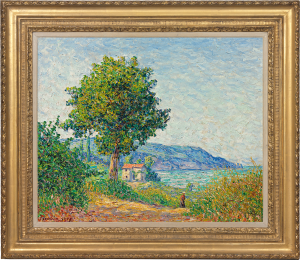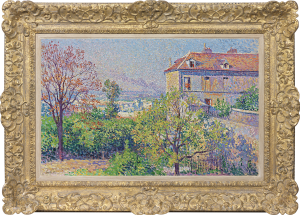Henri Fantin-Latour
Bouquet de fleurs
Oil on canvas: 20.1 x 24.5 (in) / 51.1 x 62.2 (cm)
Signed and dated upper right: Fantin . 89
This artwork is for sale.
Please contact us on: +44 (0)20 7493 3939.
Email us
HENRI FANTIN-LATOUR
Grenoble 1836 - 1904 Buré
Ref: CL 3698
Bouquet de fleurs
Signed and dated upper right: Fantin . 89
Oil on canvas: 20 1/8 x 24 ½ in / 51.1 x 62.2 cm
Frame size: 31 x 35 in / 78.7 x 88.9 cm
HENRI FANTIN-LATOUR
Grenoble 1836 – 1904 Buré
Bouquet de fleurs
Signed and dated upper right: Fantin . 89
Oil on canvas: 20 x 24 ½ in / 51.5 x 62.3 cm
Frame size: 31 x 35 in / 78.7 x 88.9 cm
Provenance:
Mrs Edwin Edwards (c.1833-1907), London, acquired from the artist
F and J Tempelaere, Paris
Alex Reid, Glasgow
John Stewart of Renfrew, Greenock, Scotland
Alex Reid and Lefevre, London, 1951
Mrs Albert D Lasker, New York, by 1953;
her sister Mrs Alice Woodard Fordyce, New York
Parke-Bernet Galleries Inc., New York, 19th May 1966, lot 7, illus. in colour
Lefevre and Marlborough, London, 1966
Sir Alfred Beit, 2nd Bt. (1903-1994), Russborough House, Blessington, Ireland
Sotheby’s London, 4th April 1989, lot 29;
Richard Green, London;
Mr Shigerki Kameyama, Tokyo, Japan, 1989
Christie’s New York, 8th November 2000, lot 11;
Richard Green, London;
private collection, USA
Exhibited:
Glasgow, Ian McNicol Galleries, Fantin-Latour, 1950, no.10
Dallas, Museum of Fine Arts, An Exhibition of 69 Paintings from the Collection of Mrs Albert D Lasker, 6th-29th March 1953, no.33
Paris, Grand Palais/Ottawa, National Gallery of Canada/San Francisco, California Palace of the Legion of Honor, Fantin-Latour, November 1982-September 1983, pp.272-3, no.104, illus. (as Summer bouquet; lent by Sir Alfred Beit)
Literature:
Mme Fantin-Latour, Catalogue de l’oeuvre complet de Fantin-Latour, Paris 1911, p.144,
no.1374
The Burlington Magazine, vol XCIII, December 1951, p.XIX, illus.
W Brockway and A Frankfurter, The Albert D Lasker Collection. Renoir to Matisse, New York 1957, p.19, illus. in colour
The Burlington Magazine, vol. CVIII, April 1966, p.xxxii, illus.
To be included in the forthcoming catalogue raisonné of the work of Henri Fantin-Latour currently being prepared by Messrs Brame and Lorenceau
Fantin-Latour here lavishes his brilliance on the flowers of high summer: the whorls of noisette roses; the ruffled skirts of hollyhocks; the silken, gossamer-thin petals of white mallows. Cottage-garden flowers, they evoke summers spent at Buré in Normandy, the property of Fantin’s in-laws. He had met the twenty-nine-year-old painter Victoria Dubourg while both were copying Old Masters in the Louvre; they married in 1876. It was a happy union, devoted to art and to music, which the couple loved.
By the late 1880s Fantin was renowned as a painter of roses, which particularly appealed to the English clientèle nurtured by his friends Edwin and Ruth Edwards. This painting is notable not just for its roses but for its abundant group of species of different shapes and aspects, also including love-in-a-mist (Nigella damascena), white phlox (Phlox paniculata) and the red clematis (Clematis viticella) which adds a fiery accent to the pastel tones of the bouquet.
When executing a flower painting, Fantin first covered the background with a neutral tone, working the brushwork so that the expanse pulsates gently, as occurs here with his light, golden-brown backdrop. The canvas was left to dry. The following day, the flowers were chosen and arranged against a neutral cloth. Unlike the Dutch Golden Age flower painters, who assembled their bouquets with flowers from every season, studied from drawings kept for reference in the studio, Fantin painted what he saw on the day. Unlike his Impressionist contemporaries, however, he had a horror of plein-air painting, of changing light and rustling breezes. He preferred to portray his flowers in the contemplative silence of his studio. Many critics have remarked that Fantin’s paintings are portraits that bring out the individuality of flowers, ‘their “inner life”…and…“fragile” and “changing beauty” ’[1]. The plain background and simple wooden table in this work push the flowers forward on the picture plane and allow us to meditate upon them without distraction. For all Fantin’s delicate personalization, however, the blooms retain their mystery as marvels of the abundance and beauty of nature.
Note on the provenance
The first owner of this work was Ruth Edwards (c.1833-1907), widow of Edwin Edwards (1823-1879), a lawyer and artist whom Fantin had met through James Whistler on his visit to London in 1861. Fantin spent several idyllic weeks painting at the Edwardses house in Surrey. Edwin and Ruth shared Fantin’s love of music, particularly Wagner; they acted as his art agents in Britain.
In the 1950s the painting was owned by Mary Lasker, widow of Albert D Lasker (1880-1952), pioneering advertizing mogul (credited with the development of the ‘soap opera’) and philanthropist. It later passed into the collection of Sir Alfred Beit, 2nd Bt. (1903-1994), nephew of the South African diamond magnate Alfred Beit, and hung at Russborough House, south of Dublin, in the company of works by Vermeer, Goya and Bellotto.
HENRI FANTIN-LATOUR
Grenoble 1836 - 1904 Buré
Henri Fantin-Latour was renowned for sensitive flower still lifes, portraits and romantic figure subjects which explored myth, history and opera. He was born in Grenoble in 1836, the son of the portrait painter Jean-Théodore Fantin-Latour and his Russian wife Helène de Naidenoff. He studied with his father from 1846 and with Horace Lecoq de Boisbaudran at the Petite Ecole de Dessin in Paris from 1850 to 1856, copying Old Masters. For some months in 1861 he studied with Gustave Courbet, but eschewed his Realism for a gentler style.
In 1858 Fantin met James McNeill Whistler and was encouraged by him to make several trips to England (1859, 1861, 1864, 1881), learning to etch from Whistler’s brother-in-law Seymour Haden. Fantin sold some of his first flower still lives through his friends Ruth and Edwin Edwards, who popularized them in England. A friendship with Edouard Manet led Fantin to exhibit at the Salon des Refusés in 1863, but he refused to take part in the first Impressionist show in 1874. He exhibited at the Salon from 1861 to 1899.
Like the Impressionists, Fantin was interested in contemporary life and from 1864 exhibited group portraits of the artistic and intellectual circles in which he moved. Edouard Manet and Charles Baudelaire, for example, are depicted in Homage to Delacroix, 1864 (Musée d’Orsay, Paris). The figures are genially interlinked, but occupy their own contemplative psychological space. The supremely elegant single portrait of Edouard Manet, 1867 (Art Institute of Chicago) breathes penetrating intelligence but also retains the subject’s mystery.
Although Fantin’s brushwork was painterly and sensuous in approach, he disliked painting en plein air, instead studying his flowers in the studio, against a plain background. In 1876 he married a fellow artist, Victoria Dubourg (1840-1926). The couple spent summers at Victoria’s family home at Buré in Lower Normandy, drawing inspiration from its abundant garden.
Parallel to Fantin’s poetic but precise observation of flowers are his imaginative figure pieces, painted and lithographed in a soft manner, full of chiaroscuro. He took themes from the Romantic music of Schumann and Berlioz and particularly the monumental, mythic operas of Wagner, in works such as Scène première du Rheingold, 1888 (Kunsthalle, Hamburg), inspired by his 1876 visit to Bayreuth. Fantin-Latour died at Buré in 1904.
The work of Henri Fantin-Latour is represented in the Louvre, Paris; the Musée d’Orsay, Paris; the National Gallery, London; the Royal Collection, London; the Thyssen-Bornemisza Museum, Madrid; the Metropolitan Museum of Art, New York; the Museum of Fine Arts, Boston; Philadelphia Museum of Art and the National Gallery of Art, Washington DC.
[1] Michel Hoog in Paris, Grand Palais etc., Fantin-Latour, 1982-3, op. cit., p.273.





























